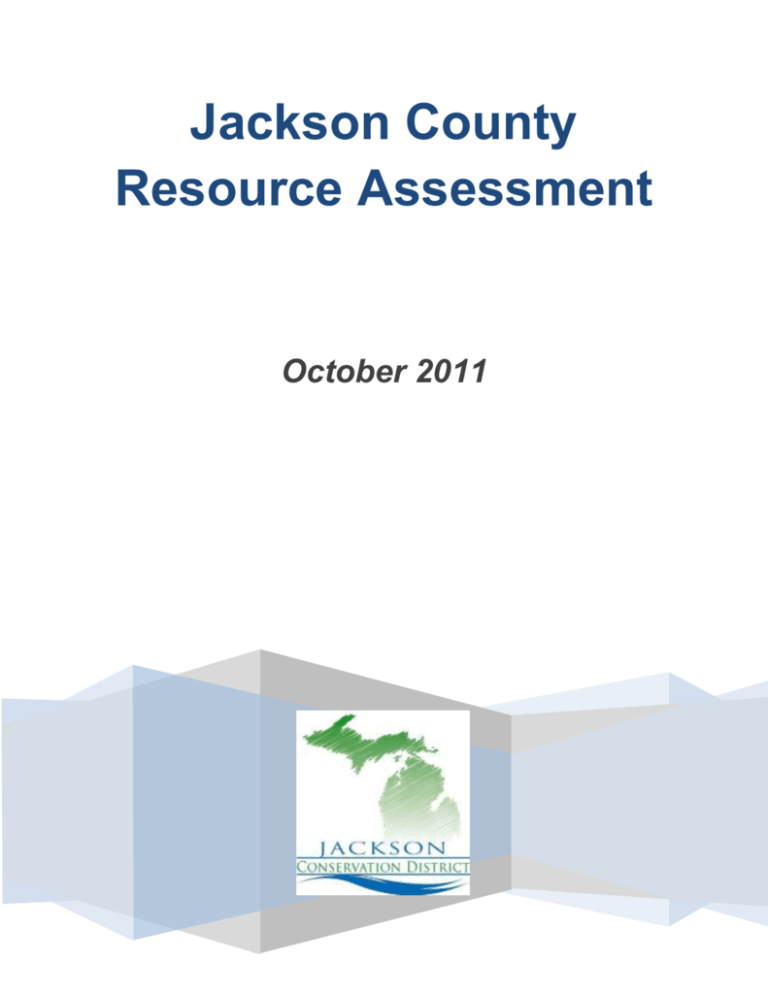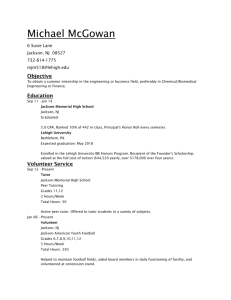2011 Jackson Resource Assessment Report
advertisement

Jackson County Resource Assessment October 2011 Jackson County Resource Assessment I. Introduction and Background During August and September of 2011, the Jackson County Conservation District (JCCD) distributed a resource survey to individuals who live in Jackson County. The purpose of this survey was to learn more about what residents think are the most important natural resource issues in our area. The results of the surveys help provide a framework for programs and services offered by JCCD in the future. The Michigan Department of Agriculture and Rural Development (MDARD) requires all Conservation Districts to complete this Resource Assessment once every five years. The mission of the Jackson County Conservation District (JCCD) is to promote wise land use decisions, based upon the capability of the natural resources of Jackson County, through technical assistance and education. Established in 1948, the District is a locally elected nonpartisan entity of State government operating under Soil Conservation District Law 297—P.A. 1937 as amended. JCCD is one of 79 county Conservation Districts throughout Michigan. Michigan’s Conservation Districts are unique local units of State government that utilize State, Federal and private sector resources to solve today’s conservation problems. The guiding philosophy of all Conservation Districts is that decisions on conservation issues should be made at the local level, by local people, with technical assistance provided by government. The types of programs and staff at each Conservation District in Michigan vary greatly because of the diversity in landscape and natural resource problems and needs. In Jackson County, the District serves as a “gateway” to conservation services and information relevant to our area. We work in partnership with other organizations to establish local conservation priorities, develop and distribute educational materials, and provide technical assistance to Jackson County residents. II. County Characteristics Demographics Jackson County has a population 160,248 people, an increase of 1.2% from the 2000 Census: 23% of the population is under the age of 18, and 13.7% of the population is 65 years old and over. The population is made up of 49% females and 51% males. The population age 25 and over consists of 88.2% that are high school graduates, and 17.5% that have a Bachelor’s degree or higher. There are 68,271 housing units in Jackson County with an ownership rate of 76.9%. The per capita income is $22,330 per year, and the median household income is $46,526 per year. In Jackson County, 14.3% of the population is below the poverty line. (USCB, 2010) Land Use and Natural Resources Jackson County has an area of about 717 square miles, or 458,880 acres. There are 1,184 farms in the county occupying 182,345 acres, which is about 40 percent of the county. About 20 percent of the land in the county is woodland. Urban and built up land makes up about 12 percent of the county. 2 Around 8 percent of the land is idle, and about 4 percent is used for parks and other recreation uses. (NASS, 2007) There are 62 different kinds of soil in Jackson County (Jackson County Soil Survey, 1981). About 60 percent of the soils in the county are well drained. Somewhat poorly drained soils make up about 9 percent. Poorly drained and very poorly drained mineral soils make up 10 percent. Very poorly drained organic soils make up about 17 percent. Urban land complexes, miscellaneous areas, and water areas make up the rest. About 700 lakes and ponds are scattered throughout the county, ranging in size from less than 3 acres to over 800 acres. There are three major drainage systems in Jackson County: the Grand River, the North and South Branches of the Kalamazoo River, and the River Raisin. In winter the average temperature is 24.7 degrees F, and the average daily minimum temperature is 17.4 degrees F. In summer the average temperature is 69.8 degrees with an average daily maximum temperature of 80.9 degrees F. The total annual precipitation in the County is 29.7 inches. Of this, 17.7 inches—or 60 percent—usually falls in April through September. Thunderstorms occur on about 40 days each year. Average seasonal snowfall is 37.4 inches. The sun shines 68 percent of the time during the summer and 36 percent of the time in the winter (USDA ,1981). Protecting Jackson County’s Natural Resources The framework for natural resources protection in the County mainly consists of the Jackson County Master Plan and the Upper Grand River Watershed Management Plan. In addition, natural resources information is incorporated at the township level in many parts of the County. For instance, Henrietta, Leoni, and Waterloo Townships have all undergone full natural resource inventories and planning and zoning reviews funded by the JCCD under the Upper Grand River Implementation Project. JCCD is also fortunate to have many dedicated environmental partner organizations working to protect natural resources in the County, including The Dahlem Conservancy, Grand River Environmental Action Team, Henrietta Conservation & Recreation Conservancy, Legacy Land Conservancy, and the Upper Grand River Watershed Alliance. Furthermore, there are local chapters of several statewide and national environmental nonprofit groups—such as the Audubon Society, Ducks Unlimited, the Nature Conservancy, and Sierra Club—that are involved in natural resource issues in Jackson County. III. Survey Methods The Resource Assessment survey was distributed as both a hard copy and as a web-based version using Survey Monkey. JCCD received 40 hard copies back and 58 online responses, for a total of 98 completed surveys. Paper copies of the survey were distributed at the Farm Bureau annual meeting in August and at the Upper Grand River Watershed bus tour in September. The survey was also printed in the fall issue of JCCD’s Conservation Corner newsletter. The electronic version of the survey was sent to email lists for the Upper Grand River Watershed Alliance and Grand River Environmental Action Team, and posted on JCCD’s website to be accessible to the general public. 3 There were ten questions included on the survey: 1. What is your zip code? 2. How long have you lived in Jackson County? □ □ □ □ Less than 1 year 1-5 years 6-10 years More than 10 years 3. How much property do you own in Jackson County? □ □ □ □ □ □ □ None (renter) Less than 1 acre 1-5 acres 6-10 acres 11-40 acres 41-100 acres Over 100 acres 4. How would you describe the setting in which you live? □ □ □ □ Urban/City Suburban Rural Residential (non-farm) Farm 5. How close do you live to the nearest lake or river? □ □ □ □ Waterfront—my property borders a lake or river Less than 1 mile Between 1-5 miles More than 5 miles 6. What are your main sources of staying informed on natural resource issues in Jackson County? Choose up to 3 answers. □ □ □ □ □ □ □ □ □ Jackson Citizen Patriot Other local newspapers Local television Radio stations Meetings of local government agencies Membership in local environmental organizations (The Dahlem Conservancy, Upper Grand River Watershed Alliance, GREAT, Audubon, etc.) Membership in agricultural organization (Farm Bureau, Ag Council, etc.) Internet Other: 7. Please select the top 3 land use issues that you think will be of the most concern in Jackson County over the next 5 years. 4 □ □ □ □ □ □ □ □ Agricultural preservation Natural areas/open space preservation Urban sprawl/development issues Adequate planning & zoning by local government Downtown revitalization Flooding/drainage issues Poor soil quality/soil degradation Other: 8. Please select the top 3 water quality issues that you think will be of the most concern in Jackson County over the next 5 years. □ □ □ □ □ □ □ □ □ □ Stormwater management Erosion/sedimentation Drinking water/source water protection Failing septic systems/bacterial contamination Residential fertilizer/pesticide use Agricultural fertilizer/pesticide use Loss of wetlands Lake management/water quality of lakes River management/water quality of rivers Other: 9. Please select the top 3 wildlife and habitat issues that you think will be of the most concern in Jackson County over the next 5 years. □ □ □ □ □ □ □ □ □ □ Loss of native habitat/fragmentation Overpopulation of wildlife Decreasing wildlife numbers/biodiversity Invasive animal species control Invasive plant species control Forestry—diseases, pests, etc. Wildlife damage to property Wildlife/habitat focused recreation opportunities Protecting threatened and endangered species Other: 10. What programs/services do you think the Jackson County Conservation District should focus more on over the next 5 years? 5 IV. Survey Results The results of the Resource Assessment are included in Table 1. Table 1. 2011 Survey Responses # of Responses— Hard Copies # of Responses— Electronic Total # of Responses 49201 [15] 49202 [1] 49224 [2] 49233 [1] 49234 [1] 49237 [1] 49240 [7] 49241 [2] 49246 [1] 49259 [1] 49269 [2] 49277 [1] 49284 [4] 49201 [13] 49202 [3] 49203 [15] 49210 [1] 49230 [4] 49237 [3] 49240 [7] 49241 [1] 49246 [1] 49259 [1] 49264 [1] 49269 [3] 49272 [3] 49284 [1] 49201 [28] 49202 [4] 49203 [15] 49210 [1] 49224 [2] 49230 [4] 49233 [1] 49234 [1] 49237 [4] 49240 [14] 49241 [3] 49246 [2] 49259 [2] 49264 [1] 49269 [5] 49272 [3] 49277 [1] 49284 [5] Less than 1 year 1-5 years 6-10 years More than 10 years How much property do you own in Jackson County? 2 0 1 37 3 5 3 47 5 5 4 84 None (renter) Less than 1 acre 1-5 acres 6-10 acres 11-40 acres 41-100 acres Over 100 acres How would you describe the setting in which you live? 4 8 9 2 3 5 13 2 20 20 4 7 4 1 6 28 29 6 10 9 14 Urban/City Suburban Rural Residential (non-farm) Farm How close do you live to the nearest lake or river? 1 4 13 27 7 14 29 8 8 18 42 35 1 10 11 Survey Question What is your zip code? How long have you lived in Jackson County? Waterfront—my property borders a lake or river 6 Less than 1 mile Between 1-5 miles More than 5 miles What are your main sources of staying informed on natural resource issues in Jackson County? Choose up to 3 answers. Jackson Citizen Patriot Other local newspapers Local television Radio stations Meetings of local government agencies Membership in local environmental organizations Membership in agricultural organization Internet Other Please select the top 3 land use issues that you think will be of the most concern in Jackson County over the next 5 years. Agricultural preservation Natural areas/open space preservation Urban sprawl/development issues Adequate planning & zoning by local government Downtown revitalization Flooding/drainage issues Poor soil quality/soil degradation Other 12 20 11 24 23 1 36 43 12 28 6 23 6 5 43 4 15 6 17 71 10 38 12 22 9 42 51 23 5 28 10 4 19 10 29 14 32 13 24 13 24 41 19 30 56 54 43 43 8 13 10 1 28 20 3 4 36 33 13 5 14 18 26 10 25 16 21 7 39 34 47 17 12 9 11 13 12 25 25 15 24 34 36 28 7 25 32 1 1 Please select the top 3 water quality issues that you think will be of the most concern in Jackson County over the next 5 years. Stormwater management Erosion/sedimentation Drinking water/source water protection Failing septic systems/bacterial contamination Residential fertilizer/pesticide use Agricultural fertilizer/pesticide use Loss of wetlands Lake management/water quality of lakes River management/water quality of rivers Other Please select the top 3 wildlife and habitat issues that you 7 think will be of the most concern in Jackson County over the next 5 years. Loss of native habitat/fragmentation Overpopulation of wildlife Decreasing wildlife numbers/ biodiversity Invasive animal species control Invasive plant species control Forestry—diseases, pests, etc. Wildlife damage to property Wildlife/habitat focused recreation opportunities Protecting threatened and endangered species Other What programs/services do you think the Jackson County Conservation District should focus more on over the next 5 years? V. 19 38 57 22 9 25 10 47 19 15 13 4 20 3 19 32 20 12 6 34 45 24 32 9 12 9 21 1 2 3 See Section V See Section V n/a Interpretations and Conclusions The survey results indicate that Jackson County residents rely on fairly traditional methods to stay informed about natural resources, mainly the local newspaper and television stations. However, memberships in environmental and agricultural organizations are also very important, and the Internet provides a lot of residents with natural resource information as well. Survey respondents listed other methods of staying informed on natural resource issues in the County, such as the JCCD newsletter and word-of-mouth from neighbors and other environmentally-minded people. Additionally, many people identified the specific environmental organizations that they receive information from (Sierra Club, Jackson Audubon, The Dahlem Conservancy, and the Grand River Environmental Action Team). Based on the survey results, the top natural resource issues of concern in Jackson County are: Land Use Issues 1. Agricultural preservation 2. Natural areas/open space preservation 3. Urban sprawl/development issues; Adequate planning & zoning by local government (tied) Water Quality Issues 1. Drinking water/source water protection 2. Stormwater management 3. Lake management/water quality of lakes Wildlife and Habitat Issues 1. Loss of native habitat/fragmentation 2. Overpopulation of wildlife 3. Invasive plant species control 8 Survey respondents also exposed natural resource issues of concern that were not listed on the survey: Oil and gas exploration/development [3] Hiking and biking trails Small farm and urban farm development Farmers removing hedgerows which harbor smaller wildlife Concentrate on WHY certain species are overabundant (deer, raccoons), and how this can be addressed. Introduction of predators, management of landscapes should be addressed. Invasive species (plant and animal) should be a top priority. The final survey question asked for guidance from the community as to what programs and services JCCD should focus on more over the next five years. The surveys revealed numerous ideas for additional programs and services: Water quality/cleaning up the lakes and rivers [6] Wildlife [4] Wetland preservation [3] Invasive plant and animal species control [3] Hunter Access Program (HAP) [2] Continuing the support of the City of Jackson storm water management to clean up the Grand River [2] More public education [2] Stormwater management and remediation for homeowners and businesses [2] Monitoring rivers and wetlands Lake preservation Increase content and wider distribution of newsletter. Newspaper and T.V. programs give poor coverage to environmental issues. Improve upkeep of County Parks. Stopping the use of pesticides in lakes polluting our water supply. Promote hydraulic cutting of weeds in lakes & use cuttings as fertilizer for local farms. Pollution of our environment both above and below ground from the Jackson County RRF. Uniform rules governing ground water contamination, rivers, streams, ponds, etc. Ag pesticide use (especially as relates to Grand River watershed). Fitness trail system for Jackson residents Weed control in local lakes Resisting Asian carp entry to Great Lakes Resisting pipeline for Canadian shale oil importation. Educating or somehow informing the general public about how serious invasive plants are and how they should manage them. Education for landowners, providing information and tools so they can be good stewards managing and protecting their land and the waters and species that are connected to it. Clean dead fall in the rivers in northern Jackson County. It is a serious threat to flooding and soil erosion. Minimize pollution. Educate public to avoid harm to environment--waterways, land, air. Promoting BMPs for farmers and residential owners Promoting recreational access to land and water 9 Buffers areas for runoff from agricultural and residential areas Enacting and supporting Region II's "Greenways Plan"...it's not perfect, but it's the best plan available for dealing with ALL the issues JCCD should work on. Explaining why we need to protect our watershed, and demonstrating how fortunate we are to have abundant, relatively clean water in Jackson County. Supporting the regional agricultural industry. Provide education on the economic value of green infrastructure and natural resource assets. Grand River protection Education of the general public on how to be better stewards of the environment. Too much of the current focus is on the Ag community. This will take some PR efforts so the community understands the value of the JCCD. Development/zoning Continue to be a leader in conservation in the county, a place where people can find information. Stabilize/increase JCCD funding to continue water quality programs Perhaps develop fee for service program to assist Jackson residents/businesses develop rain gardens, etc. for stormwater utility fee credits. More plant sales: less trees and more bushes and ornamentals Conservation Reserve Program (CRP) Environmental Quality Incentives Program (EQIP) Wildlife destruction Emerald ash borer containment Controlling invasive weeds/water plants like purple loosestrife Diseases and pests Cover crops Erosion Saving agricultural land Minimizing the number of sandhill cranes, deer, and turkey Demonstration projects Native species Local foods Work with Farm Bureau to help educate landowners Environmental education with landowners and school-aged kids Maintaining large tracks of natural areas Trends and Recommendations for Future Efforts There were definite trends among the survey responses that should guide future efforts led by JCCD. Water quality and stormwater management issues are of top concern to Jackson residents, thus JCCD should remain active in these areas and seek additional funding and partnerships to protect water resources. Invasive species control is of great concern to residents as well. JCCD could work with Michigan State University Extension and the Stewardship Network to improve public outreach on these issues. JCCD should also become more involved with Jackson County farmland preservation efforts, as agricultural and natural areas preservation are a high priority for County residents. 10 Sources National Agricultural Statistics Service. (2007). Census of Agriculture Jackson County Conservation District. (2011). www.jacksoncd.org United States Department of Agriculture, Soil Conservation Service. (1981). Jackson County Soil Survey. United States Census Bureau. (2010). 2010 Census. http://quickfacts.census.gov/qfd/states/26/26075.html 11








